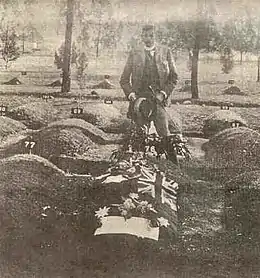Peter Handcock
Peter Joseph Handcock (17 February 1868 – 27 February 1902) was an Australian-born Veterinary Lieutenant who served in the Bushveldt Carbineers during the Boer War in South Africa.
Peter Handcock | |
|---|---|
.jpeg.webp) Peter Joseph Handcock (1900) | |
| Birth name | Peter Joseph Handcock |
| Born | 17 February 1868 near Bathurst, New South Wales, Australia |
| Died | 27 February 1902 (aged 34) Pretoria, South African Republic |
| Allegiance | British Empire |
| Years of service | 1899 – 1902 |
| Rank | Lieutenant |
| Unit | 1st New South Wales Mounted Rifles Bushveldt Carbineers |
| Battles/wars | Second Boer War |
| Spouse(s) | Bridget Alice Mary Martin (1888–1902; his death) |
| Children | 3 |
After a court martial, Handcock (along with Harry "Breaker" Morant) was convicted and executed for the murder of several Boer prisoners-of-war.[1]
His execution, "which had been carried out without the knowledge and consent of the Australian government",[2] was and remains a controversial issue in Australia.
Life
Peter Joseph Handcock was born at Peel, near Bathurst, New South Wales to William Handcock (1830–1874), and Bridget Handcock, née Martin (1830–1881) on 17 February 1868 [3]
He was apprenticed to a blacksmith at age 12, and later worked as a blacksmith with the Railways Department.[3]
He married his 17-year-old cousin Bridget Alice Mary Martin on 15 July 1888, and they had two sons and a daughter.[3]
Military service
He served in South Africa with the 1st New South Wales Mounted Rifles, and was promoted to Farrier-Sergeant.
When the NSWMR returned home he obtained a commission in the Bushveldt Carbineers as Veterinary and Transport Officer.[2]

| External image | |
|---|---|
Source:Genealogical Society of South Africa |
Execution
Handcock and Morant were convicted, court-martialled, found guilty, and executed in Pretoria by a firing squad drawn from the Queen's Own Cameron Highlanders on 27 February 1902 on murder charges for shooting nine Boer prisoners.
Although the defendants were found guilty of killing these enemy combatants, they were acquitted of murdering a South African missionary, Reverend Daniel Heese.[2] However In 1929, it was revealed by George Witton in a letter to James Francis Thomas that Handcock had confessed to Witton of murdering Heese just after he was acquitted.[4]
Petitions for review of convictions and sentences
In 2010, petitions were submitted for the review of the convictions of Handcock and his colleagues.[5]
See also
Footnotes
- The murders are often prochronistically denoted "war crimes"; a concept that did not exist at the time.
- Wallace (1983).
- Australian Boer War Memorial.
- Williams, Richard. "Witton's Letter to Thomas 21 October 1929". Retrieved 21 April 2020.
- The transcript of the committee's hearing is at Public hearings and roundtable discussions Archived 2010-05-05 at the Wayback Machine Parliament of Australia - House of Representatives
References
- Probate Jurisdiction, The Sydney Morning Herald, (Thursday, 23 June 1904), p.8.
- The Bushveldt Carbineers and the Pietersburg Light Horse by William (Bill) Woolmore (2002, Slouch Hat Publications Australia) ISBN 0-9579752-0-1
- Unkles, James, Ready, Aim, Fire : Major James Francis Thomas, the Fourth Victim in the Execution of Lieutenant Harry "Breaker" Morant, Sid Harta Publishers, (Glen Waverley), 2018. ISBN 978-1-9252-3050-5
- The Australian Boer War Memorial: Lieutenant Peter Handcock.
- Wallace, R.L., "Handcock, Peter Joseph (1868–1902)", pp.185-185 in B. Nairn, G. Serle, and C. Cunneen (eds), Australian Dictionary of Biography: Volume 9: 1891-1939, Gil-Las, Melbourne University Press, (Carlton), 1983.
